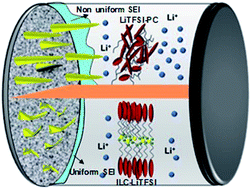Anisotropic mass transport using ionic liquid crystalline electrolytes to suppress lithium dendrite growth†
Abstract
Lithium metal as an anode has been widely accepted due to its higher negative electrochemical potential and theoretical capacity. Nevertheless, the existing safety and cyclability issues limit lithium metal anodes from practical use in high-energy density batteries. Repeated Li deposition and dissolution processes upon cycling lead to the formation of dendrites at the interface which results in reduced Li availability for electrochemical reactions, disruption in Li transport through the interface and increased safety concerns due to short circuiting. Here, we demonstrate a novel strategy using Ionic Liquid Crystals (ILCs) as the electrolyte cum pseudo-separator to suppress dendrite growth with their anisotropic properties controlling Li-ion mass transport. A thermotropic ILC with two-dimensional Li-ion conducting pathways was synthesized and characterized. Microscopic and spectroscopic analyses elucidate that the ILC formed with a smectic A phase, which can be utilized for wide temperature window operation. The results of electrochemical studies corroborate the efficacy of ILC electrolytes in mitigating dendrite formation even after 850 hours and it is further substantiated by numerical simulation and the mechanism involved in dendritic suppression was deduced.



 Please wait while we load your content...
Please wait while we load your content...